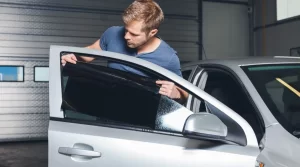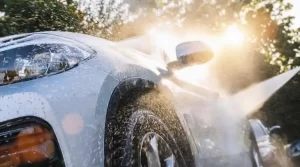How can you prevent winter paint damage to your automobile or truck? We take great care in our paint job. A well-maintained car always shines when you shake off the road grime, so you can tell. True, now and then a piece of gravel from the road may scrape the fender or damage your flawless paint, but that’s life. However, the risk of paint damage multiplies throughout the winter.
A flawless paint job is seriously at risk during the winter, and even small existing blemishes can make it worse. Many drivers create a plan to protect their paint during the winter when the roadways are covered in corrosive salt crystals and snow can settle on your car in under an hour of parking outside. Coatings are poisonous and a headache to match with materials, and wax doesn’t last. We’ve discovered that PPF, or Paint Protection Film, is ultimately the most attractive, useful, and practical solution for keeping your car’s paint protected during the winter.
Since that is what it was intended for. But don’t just believe what we say. Let’s explore the practical advantages of PPF for preserving your car’s paint in the winter.
THE RISKS OF THE WINTER TO YOUR PAINT JOB
How damaging is winter to car paint? If you haven’t looked closely, there are some significant issues with the integrity of the paint throughout the winter.
- Winter Roads with Salt and Sand
- Loose Gravel Is Caused by Road Damage
- The Infiltration of Moisture into Paint Scratches
- Very Cold Conditions
- Sleet and Stones from Hail
By nature, de-icing agents are caustic. Winterizing your car chips away at the paint and exacerbates any damage already there. Yet, there is a significant risk from flying gravel and hail, both of which are more frequent during stormy winters. As temperature drops make paint fragile and snow piles can allow moisture to seep into already existing fissures, even lightly stacking snow might present a problem.
In other words, winter has never been good for perfectly maintained car paint.
1) DE-ICING AGENTS ARE PROTECTED FROM THE PAINT
The main problem is the sand and salt on the winter roadways. The particles are continually being thrown onto your bumpers and from the car in front of you, even though these are necessary for safe tire traction. In addition to being sharp enough to scratch, the particles also progressively corrode anything they come in contact with. everything, even your paint.
PPF offers a transparent, thin layer of protection that is necessary to prevent corrosive de-icing products from ever reaching your paint or even the finish of your fender. Your vehicle is completely covered in the film, so there won’t be any wintertime salt damage.
2) PREVENTS LOOSE GRAVEL SCRATCHES AND POCKS
Everyone is aware that winter brings deteriorated roads. Any asphalt will become worn down due to the rains and temperature drops. Because salt has done its corrosive work overtime in snowy areas, there is more loose gravel in the winter than at other times of the year. The main cause of the microscopic pock-mark scratches in your paint that can eventually cause more harm is loose gravel.
Against gravel, the paint protection film is excellent. Because it is a film, it is slightly pliable as opposed to being brittle. This makes it simple to “bounce” stones off the surface of your automobile without leaving a bothersome scratch or paint crater.
3) PREVENTS CURRENT SCRATCHES FROM BECOMING WET FROM SNOW.
Snow becomes the enemy of longevity once you do have a few gravel chips in your paint. Snow that accumulates on your automobile during the winter might contain moisture that can seep into minor paint imperfections. This may expose metal automobile frames to rust or further lift the paint. A PPF-coated car is already perfectly protected from moisture infiltration regardless of how long it is buried under a snowdrift during harsh weather because moisture is even simpler to reject than salt.
4) PRIMARY LINE OF ATTACK AGAINST HAILSTONES
Hail is a danger for vehicles in stormy areas during the winter, particularly in the early and late winter months when the seasons are changing. Hail, tiny ice specks that drop from the sky, may completely wreck a car lot. Thus it should come as no surprise that if your car is subjected to those ice pieces flying around, it will suffer paint damage.
In the same way that it shields your automobile from flying debris, the paint protection film is excellent at deflecting hail. Hail is like ice gravel that falls from the sky, and it poses a comparable risk to your paint. The only distinction is that hail can strike your car hundreds to thousands of times while flying gravel just occasionally damage the paint. Even if you must commute in particularly harsh weather, PPF can keep the hail at bay.
5) PROTECTION AGAINST EXTREME COLD
PPF can even assist shield your car from temperatures that drop below zero. Most finishes dislike extremely cold temperatures and can become more fragile when the temperature lowers, particularly if it does so quickly. PPF offers a locked-on coating of flexible protection that holds your paint in place and mildly insulates it to stop any unintended reactions to the extreme cold in your area.
6) BENEFICIAL TO THE ENVIRONMENT
You might not be aware that PPF is also the greenest option. To get continuous winter paint protection, you need to reapply spray-on and paint-on protective finishes, which use solvents that are released into the air or washed down the drain. Paint Protection Film is applied once, and no chemical solvents are needed. There is no need to use more than one product because it can be applied to every surface and finish of your car’s exterior, and it lasts considerably longer than any chemically applied finish coating.
7) LAST WINTER LONG PAST
How long does PPF remain after being applied to protect the paint from the winter? More than one winter has passed already. A well-applied, high-quality PPF typically lasts 5-7 years. If you apply paint protection film to your car this winter, you won’t need to consider another sort of paint protection for five more winters (and every other season in between).
Want to prevent scuffs and maintain the beauty of your paint during winter? Want to shield your finish against ice and salt damage? To learn more about the PPF application for your vehicle, contact us right away. Our knowledge of automotive films extends well beyond windows at Bronx Window Tinting. Allow us to assist you in locating the appropriate paint protection film for your car so that you can keep your paint protected for at least the next five years. We are eager to collaborate with you.







